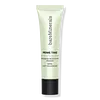What's inside
What's inside
 Key Ingredients
Key Ingredients

 Benefits
Benefits

 Concerns
Concerns

 Ingredients Side-by-side
Ingredients Side-by-side

Water
Skin ConditioningGlycerin
HumectantAlcohol Denat.
AntimicrobialDimethicone
EmollientAmmonium Polyacryloyldimethyl Taurate
Emulsion StabilisingSilica
AbrasivePhenoxyethanol
PreservativeCapryloyl Glycine
CleansingCetyl Dimethicone
EmollientCarbomer
Emulsion StabilisingSilica Silylate
EmollientBoron Nitride
AbsorbentCaprylyl Glycol
EmollientBis-PEG-18 Methyl Ether Dimethyl Silane
EmollientButylene Glycol
HumectantDimethicone/PEG-10/15 Crosspolymer
Cetearyl Alcohol
EmollientSodium Hydroxide
BufferingTrisodium Ethylenediamine Disuccinate
Totarol
AntioxidantAloe Barbadensis Leaf Juice Powder
Skin ConditioningGlyceryl Acrylate/Acrylic Acid Copolymer
HumectantCetearyl Glucoside
EmulsifyingDipropylene Glycol
HumectantZingiber Officinale Root Extract
MaskingSanguisorba Officinalis Root Extract
CleansingCinnamomum Cassia Bark Extract
MaskingSodium Citrate
BufferingCI 14700
Cosmetic ColorantTocopherol
AntioxidantWater, Glycerin, Alcohol Denat., Dimethicone, Ammonium Polyacryloyldimethyl Taurate, Silica, Phenoxyethanol, Capryloyl Glycine, Cetyl Dimethicone, Carbomer, Silica Silylate, Boron Nitride, Caprylyl Glycol, Bis-PEG-18 Methyl Ether Dimethyl Silane, Butylene Glycol, Dimethicone/PEG-10/15 Crosspolymer, Cetearyl Alcohol, Sodium Hydroxide, Trisodium Ethylenediamine Disuccinate, Totarol, Aloe Barbadensis Leaf Juice Powder, Glyceryl Acrylate/Acrylic Acid Copolymer, Cetearyl Glucoside, Dipropylene Glycol, Zingiber Officinale Root Extract, Sanguisorba Officinalis Root Extract, Cinnamomum Cassia Bark Extract, Sodium Citrate, CI 14700, Tocopherol
Water
Skin ConditioningDecyl Cocoate
EmollientCoco-Caprylate/Caprate
EmollientCaprylic/Capric Triglyceride
MaskingTriheptanoin
Skin ConditioningKaolin
AbrasivePropanediol
SolventAvena Sativa Kernel Oil
Skin ConditioningCetearyl Olivate
Cellulose
AbsorbentOleyl Erucate
EmollientSqualane
EmollientSorbitan Olivate
EmulsifyingC9-12 Alkane
SolventDilinoleic Acid/Butanediol Copolymer
Chamomilla Recutita Flower Extract
MaskingHelianthus Annuus Seed Oil
EmollientTocopherol
AntioxidantBisabolol
MaskingSalicyloyl Phytosphingosine
Skin ConditioningPentaerythrityl Tetra-Di-T-Butyl Hydroxyhydrocinnamate
AntioxidantSulfur
AntiseborrhoeicHydrogenated Palm Glycerides Citrate
EmollientZinc Ricinoleate
Magnesium Aluminum Silicate
AbsorbentCetearyl Alcohol
EmollientCetyl Palmitate
EmollientGlycerin
HumectantSorbitan Palmitate
EmulsifyingEthylene/Propylene/Styrene Copolymer
Xanthan Gum
EmulsifyingSorbitan Oleate
EmulsifyingCastor Oil/Ipdi Copolymer
Acacia Senegal Gum
MaskingMica
Cosmetic ColorantButylene/Ethylene/Styrene Copolymer
Phenoxyethanol
PreservativeCI 77163
Cosmetic ColorantCI 77289
Cosmetic ColorantCI 77288
Cosmetic ColorantZinc Oxide
Cosmetic ColorantWater, Decyl Cocoate, Coco-Caprylate/Caprate, Caprylic/Capric Triglyceride, Triheptanoin, Kaolin, Propanediol, Avena Sativa Kernel Oil, Cetearyl Olivate, Cellulose, Oleyl Erucate, Squalane, Sorbitan Olivate, C9-12 Alkane, Dilinoleic Acid/Butanediol Copolymer, Chamomilla Recutita Flower Extract, Helianthus Annuus Seed Oil, Tocopherol, Bisabolol, Salicyloyl Phytosphingosine, Pentaerythrityl Tetra-Di-T-Butyl Hydroxyhydrocinnamate, Sulfur, Hydrogenated Palm Glycerides Citrate, Zinc Ricinoleate, Magnesium Aluminum Silicate, Cetearyl Alcohol, Cetyl Palmitate, Glycerin, Sorbitan Palmitate, Ethylene/Propylene/Styrene Copolymer, Xanthan Gum, Sorbitan Oleate, Castor Oil/Ipdi Copolymer, Acacia Senegal Gum, Mica, Butylene/Ethylene/Styrene Copolymer, Phenoxyethanol, CI 77163, CI 77289, CI 77288, Zinc Oxide
Alternatives
Ingredients Explained
These ingredients are found in both products.
Ingredients higher up in an ingredient list are typically present in a larger amount.
Cetearyl alcohol is a mixture of two fatty alcohols: cetyl alcohol and stearyl alcohol. It is mainly used as an emulsifier. Emulsifiers help prevent the separation of oils and products. Due to its composition, it can also be used to thicken a product or help create foam.
Cetearyl alcohol is an emollient. Emollients help soothe and hydrate the skin by trapping moisture.
Studies show Cetearyl alcohol is non-toxic and non-irritating. The FDA allows products labeled "alcohol-free" to have fatty alcohols.
This ingredient is usually derived from plant oils such as palm, vegetable, or coconut oils. There is debate on whether this ingredient will cause acne.
Due to the fatty acid base, this ingredient may not be Malassezia folliculitis safe.
Learn more about Cetearyl AlcoholGlycerin is already naturally found in your skin. It helps moisturize and protect your skin.
A study from 2016 found glycerin to be more effective as a humectant than AHAs and hyaluronic acid.
As a humectant, it helps the skin stay hydrated by pulling moisture to your skin. The low molecular weight of glycerin allows it to pull moisture into the deeper layers of your skin.
Hydrated skin improves your skin barrier; Your skin barrier helps protect against irritants and bacteria.
Glycerin has also been found to have antimicrobial and antiviral properties. Due to these properties, glycerin is often used in wound and burn treatments.
In cosmetics, glycerin is usually derived from plants such as soybean or palm. However, it can also be sourced from animals, such as tallow or animal fat.
This ingredient is organic, colorless, odorless, and non-toxic.
Glycerin is the name for this ingredient in American English. British English uses Glycerol/Glycerine.
Learn more about GlycerinPhenoxyethanol is a preservative that has germicide, antimicrobial, and aromatic properties. Studies show that phenoxyethanol can prevent microbial growth. By itself, it has a scent that is similar to that of a rose.
It's often used in formulations along with Caprylyl Glycol to preserve the shelf life of products.
Tocopherol (also known as Vitamin E) is a common antioxidant used to help protect the skin from free-radicals and strengthen the skin barrier. It's also fat soluble - this means our skin is great at absorbing it.
Vitamin E also helps keep your natural skin lipids healthy. Your lipid skin barrier naturally consists of lipids, ceramides, and fatty acids. Vitamin E offers extra protection for your skin’s lipid barrier, keeping your skin healthy and nourished.
Another benefit is a bit of UV protection. Vitamin E helps reduce the damage caused by UVB rays. (It should not replace your sunscreen). Combining it with Vitamin C can decrease sunburned cells and hyperpigmentation after UV exposure.
You might have noticed Vitamin E + C often paired together. This is because it is great at stabilizing Vitamin C. Using the two together helps increase the effectiveness of both ingredients.
There are often claims that Vitamin E can reduce/prevent scarring, but these claims haven't been confirmed by scientific research.
Learn more about TocopherolWater. It's the most common cosmetic ingredient of all. You'll usually see it at the top of ingredient lists, meaning that it makes up the largest part of the product.
So why is it so popular? Water most often acts as a solvent - this means that it helps dissolve other ingredients into the formulation.
You'll also recognize water as that liquid we all need to stay alive. If you see this, drink a glass of water. Stay hydrated!
Learn more about Water